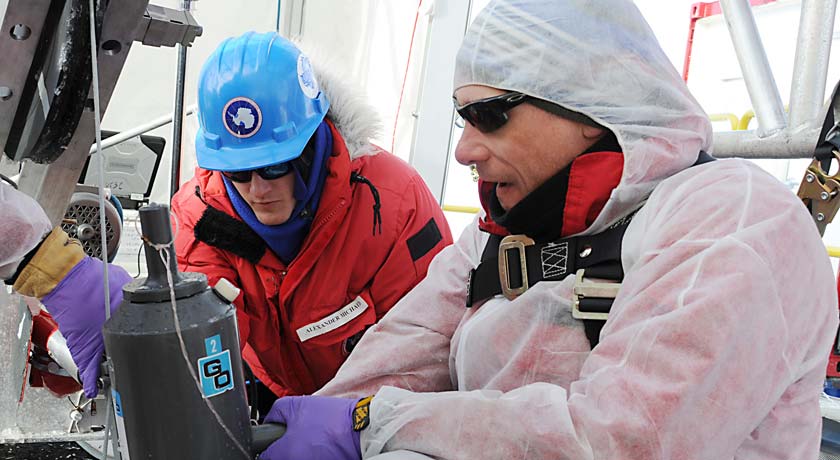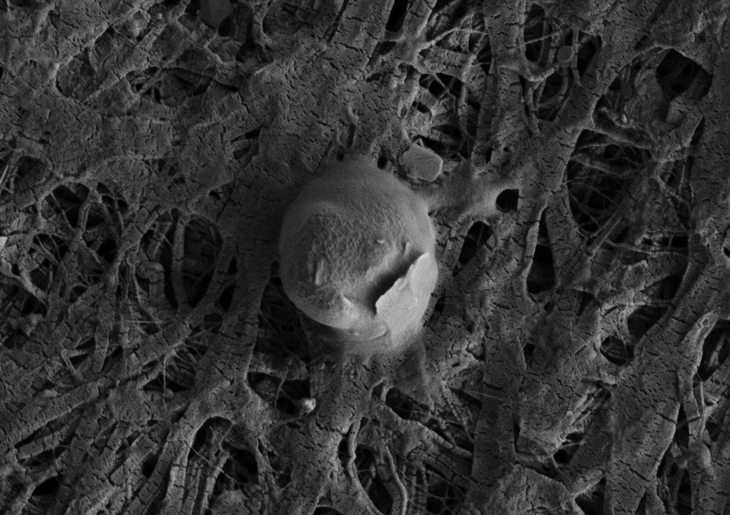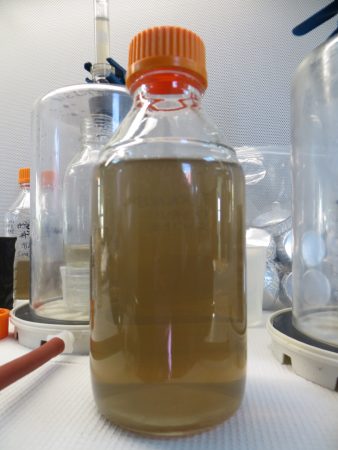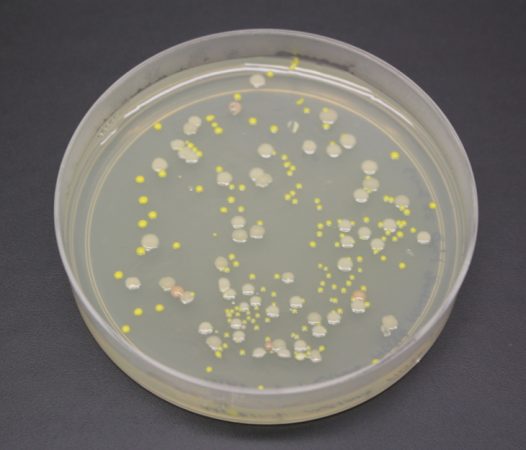Buried Antarctic lake teems with life
Microbes living in a lake deep under ice buoy the idea that life may inhabit otherworldly sites

Brent C. Christner (right), of Lousiana State University, and Alex Michaud, of Montana State University, retrieve the first water sample from Antarctica's Lake Whillans.
Reed Scherer, Northern Illinois University
On Jan. 28, 2013, a team of U.S. scientists retrieved water from a liquid lake deep below the thick, West Antarctic Ice Sheet. Within hours, excited biologists reported they had found what they were looking for: live cells. But they refused to say more. Now, 19 months later, they’re ready to talk.
“The number of microorganisms we saw in the water was very comparable with what you’d find in a typical surface lake or in the ocean,” notes Brent Christner. “We were very surprised.”
Christner works at Louisiana State University in Baton Rouge. Last year, this microbiologist led the team of biologists in Antarctica that initially analyzed water from Lake Whillans. Christner also led the scientific team that now describes those microbes in the Aug. 21 Nature.
The U.S. research team had used hot water to carefully tunnel 800 meters (roughly a half-mile) down through ice until it breached the surface of Lake Whillans. Then they hoisted 30 liters (8 gallons) of the lake’s water to the surface. In it, they found a surprising abundance of bacteria and other one-celled organisms called archaea. Each thimbleful of water contained roughly 130,000 cells. In all, the biologists found 3,931 microbial species or groups of species.
All had been living in the lake’s pitch-black water. Its temperature was a frigid 0.49° Celsius (31.1° Fahrenheit) at the time of sampling. By looking at the isotope of oxygen that dominated in the water, they could see that it matched that of the glacier ice above. That indicated the lake’s water had melted off the bottom of the glacial ice sheet. Indeed, the thick glacial ice serves like a blanket to insulate the lake from temperatures at the surface, which remain below freezing year-round.

Keeping the lake clean
For decades scientists had known that a network of rivers and more than 400 subglacial lakes crisscross the bottom of Antarctica’s 14-million square kilometer (5.4-million square mile) ice cover. Geothermal warmth is responsible for turning the base of some of the glacial ice into this liquid water.
Five years ago, researchers reported finding life in cores of ice collected above Vostok, a subglacial lake much deeper than Whillans. Critics, back then, had argued that the few cells recovered above Lake Vostok might simply be due to contamination. The drilling equipment might have brought down surface germs. Since then research teams from Russia, the United Kingdom and the United States have each launched drilling efforts to search for proof of life tucked away under the Antarctic ice.

For its work at Lake Whillans, the U.S. research team created a new type of hot-water drill. It heats up filtered water. That water then melts a hole down through the ice.
That drill water gets so hot that it should kill any microbes trying to hitchhike down from the surface. The drill system further disinfects the water with hydrogen peroxide. Lastly, the water is zapped with intense ultraviolet light to kill off any remaining germs.
Each minute that the drill operated, it pumped more than 113 liters of water — enough to fill a typical bathtub. That water traveled down what Christner describes as a kilometer-long industrial garden hose. Along the way, that water melted a cylindrical hole 60 centimeters (23.6 inches) wide.
These precautions weren’t just to get a clean, scientific result. Explains Christner, “The last legacy that we’d want to leave is messing up the lake with foreign material that might alter it.”
Even the lake itself was selected to minimize environmental problems, Christner says. Vostok’s water has likely been in that lake for more than 10,000 years. By contrast, the water in Lake Whillans flushes out every few years. By choosing to work with a relatively quick-flushing lake, the U.S. team figured it would cut any chance of long-term contamination if there had been a drilling mishap.
A window into life on other worlds?
Unlike microbes living on Earth’s surface, Lake Whillans’ inhabitants live a pitch-black existence. Without sunlight for photosynthesis, many of the organisms instead eat away at the surrounding rock and produce energy by oxidizing iron. (Oxidation is a chemical reaction that involves one molecule’s theft of an electron from another.)

Christner suggests that the vibrant ecosystem fueled by these rock-chomping microbes supports the possibility of life elsewhere in the solar system. Such as where? Perhaps at Mars’ polar icecaps or on Jupiter’s moon Europa, he says.
“If you took one of these microbes and put it under an ice sheet where there’s water on another planet, I don’t think [the microbes] could tell the difference,” Christner says.
Martyn Tranter is a biogeochemist at the University of Bristol in England. “It’s not too much of a stretch of the imagination,” he says, to now think “that ice sheet beds on other planets and terrestrial bodies can be hosts to microbial life.” Having definitive proof of life under the Antarctic ice sheet also provides insight into how life might cope with something as devastating as a global nuclear war, he argues. Afterward, there would likely develop what physicists refer to as a “a nuclear winter or snowball Earth.” Yet even under such extreme conditions, he says, “these microbes would still carry on.”
Power Words
Antarctica A continent mostly covered in ice, which sits in the southernmost part of the world.
archaeon (plural archaea) A domain of life that includes single-celled organisms. Although archaea superficially resemble bacteria, they are distinct. Archaea inhabit many harsh environments.
bacterium (pluralbacteria) A single-celled organism forming one of the three domains of life. These dwell nearly everywhere on Earth, from the bottom of the sea to inside animals.
biogeochemistry A term that covers processes that cycle (or eventually deposit) pure elements or chemical compounds (including minerals) between living species and nonliving parts (such as rock or soil or water) within an ecosystem. A scientist who works in this field is a biogeochemist.
ecosystem A group of interacting living organisms — including microorganisms, plants and animals — and their physical environment within a particular climate. Examples include tropical reefs, rainforests, alpine meadows and polar tundra.
Europa The fourth largest moon of Jupiter. Europa, 1,951 miles across, has a network of dark lines on a bright, icy surface.
glacier A slow-moving river of ice hundreds or thousands of meters deep. Glaciers are found in mountain valleys and also form parts of ice sheets.
hydrogen peroxide A molecule made of two hydrogen and two oxygen atoms. Highly reactive, it can kill many tiny organisms, including germs.
ice sheet The broad blanket of ice, most of it kilometers deep, that covers most of Antarctica. An ice sheet also blankets most of Greenland.
isotopes Different forms of an element that vary somewhat in weight (and potentially in lifetime). All have the same number of protons but different numbersneutrons in their nucleus. As a result, they also differ in mass.
microbe Short for microorganism. (see microorganism)
microorganism A living thing that is too small to see with the unaided eye, including bacteria, some fungi and many other organisms such as amoebas. Most consist of a single cell.
oxidation A process that involves one molecule’s theft of an electron from another. The victim of that reaction is said to have been “reduced.” It can make itself whole again by robbing an electron from another molecule, triggering another case of oxidation. These chemical reactions are so violent, chemically, that they can easily kill cells. The oxidative reaction often involved oxygen atoms — but not always.
photosynthesis (verb: photosynthesize)The process by which green plants and some other organisms use sunlight to produce foods from carbon dioxide and water.
terrestrial An adjective for things of or relating to Earth
ultraviolet A portion of the light spectrum that is close to violet but invisible to the human eye.







